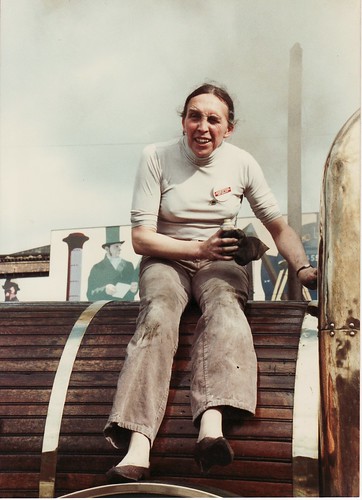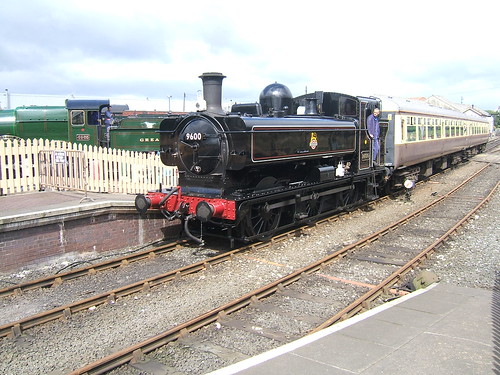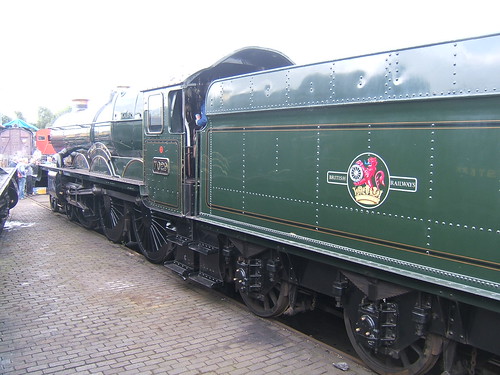In the post Mutual Improvement Classes, I outlined the aims of the MIC of steam days. This index has links to posts labelled 'MIC' in my blog. Titles starting 'MIC' have been used as talks before appearing here, other posts are included because of the amount of technical content which I hope may be of some help to volunteers studying locomotive work.
Where a topic is split into more than one post, links are normally provided forwards and backwards, but note that unconnected posts may deal with a similar theme. I'm sorry if it appears confusing, but the Search Box (with the magnifying glass symbol) in the header can always be used to find posts including any particular word or phrase.
Other topics are in preparation but, unfortunately in an unstructured manner.
Caledonian Railway preserved 0-4-4 tank engine No. 419 at the Battlefield Line 21-Jan-2023
Battlefield Line Mince Pie Specials 2022 3-Mar-2022
Battlefield Line 'Santa' Trains 2021 29-Jan-2022
Class 20 Diesel Electric Locomotive 08-Jan-2022
A Day on the DMU13-Nov-2021
Getting Back on Track 6-Nov-2021
Origins of the Great Western Vacuum Brake 8-Nov-2020
Battlefield Line Bonfire and Firework display at Market Bosworth Station 19-Nov-2019
Shackerstone Railway Society 50th Anniversary Steam Gala 16-Nov-2019
Operation of Steam/Diesel Multiple Unit Services at the Battlefield Line 10 Nov-2019
Fish and Chip Special 11-Oct-2019
Preparing 5542 (part 2) 6 Aug 2019
5542 at the Battlefield Line in 2019 30 Jul 2019
'Pannier' 6430 at the Battlefield Line 4-Apr-2019
Battlefield Line Steam Gala 2018 (Part 2) 4-Jan-2019
Battlefield Line Steam Gala 2018 (Part 1) 16-Oct-2018
Preparing 5542 (part 1) 14-Sep-2018
Battlefield Line 'Family Fun Weekend' 3 Sep 2018
5542 at the Battlefield Line 28 Aug 2018
Talking about Engines 19 Apr 2018
Class 08 User Manual 24 Mar 2018
Passed Fireman 24 Mar 2018
Santa Specials at the Battlefield Line 2017 19 Dec 2017
On the Footplate 5 Dec 2017
On the Footplate: the Drummond 'T9' 17 Sep 2017
Two Failures 16 Sep 2017
The Role of the Shunter (2) 26 Aug 2017
The Role of the Shunter 29 Aug 2017
Bank Holiday with Steam and Diesel 7 Jun 2017
British Locomotive Headcodes 1-Feb-2017
Shackerstone Santa Specials 28-Dec-2016
Peak Rail Santa Specials 23-Dec-2016
'Operation: Market Bosworth' - On the Footplate 8-Oct-2016
Electrical Systems on Steam Locomotives 14-Sep-2016
The Railway at Night 11 Sep 2016
Locomotive Regulators (part 2) 11 Sep 2016
Peak Rail Winter Service 2013 22 August 2016
Sunday at Shackerstone 4 April 2016
Driving the 'Planet' replica 11 September 2015
Water, water, everywhere 19 July 2015
HST Charter to Peak Rail 12 March 2014
Peak Rail in early 2014 11 March 2014
Battlefield Line 1940s Weekend (June 2013) 18 June 2013
Preparation of Locomotive 'Sapper' 8 January 2013
The Clack Valve 19 November 2012
A Day on the Footplate (2) 25 June 2012
A Day on the Footplate (1) 9-Jun-12
Driving 'Lion' 13 January 2012
Battlefield Line Santa Specials 2011 18 December 2011
Summer Saturday with a '2884' 4 September 2011
On the Footplate (Part 2) 7 January 2011
On the Footplate (Part 1) 22 July 2010
The Best Laid Schemes ... 9 July 2010
Stanier '8F' inauguration at Peak Rail 28 May 2009
Diesel Multiple Units 23 May 2010
MIC - Brakes 11 January 2009
MIC - Disposal 10 January 2009
MIC - Firing Steam Locomotives (1) 10 January 2009
MIC - The Working of Trains 2 January 2009
Driving Turn at Peak Rail - Part Two: Driving Experience 31 December 2008
MIC - Lamps 31 December 2008
Firing a 'B1' 11 October 2008
Driving Turn at Peak Rail - Part One: Preparation 6 May 2008
Mutual Improvement Classes 24 February 2008
Locomotive Regulators (part 1) 17 July 2007
Sunday at Peak Rail: 15 January 2007
Early Locomotive Design 12 January 2007
'Henry' 12 January 2007
You can select all the posts in this blog labelled 'MIC' by clicking here.
[List updated: 30-May-2017, 29-Aug-2017, 23-Mar-2018, 8-Apr-2018, 4-Sep-2018, 14-Sep-2018, 8-Aug-2019: List updated and sequence reversed 28-Jan-2023]
Sunday, 9 October 2016
Birmingham Railway Museum, Tyseley
I was a 'late starter' in railway preservation, but in 1988 I joined the 'Lion' supporters group, the Old Locomotive Committee (OLCO), following a series of coincidences I've described in the post Lion. It appears that my life is guided by this sort of 'Happy Accident' as I commented in another post here.

'Lion' at Manchester Museum of Science and Industry In 1988, with a much-younger Jan.
'Lion' had been returned to steam to celebrate her 150th Birthday (or, as The Old Locomotive Committee preferred to call it "The Sesquicentenary"), visiting various sites around the country. From Crewe, where I first became involved, she went to the Manchester Museum of Science and Industry, The Science Museum at Wroughton and made two visits to Birmingham Railway Museum, Tyseley. Having become a member of OLCO, I accompanied the venerable locomotive on these public appearances. During the visit to Tyseley, one of the OLCO members let on about my interest in railway signalling. Since the Museum's plans for a new demonstration line incorporating a Great Western signalbox (relocated from Holesmouth Junction) were well advanced, new volunteer members were being actively recruited for the Museum and I was invited - no, instructed - to join. Having had no previous involvement with railway preservation, I thus found suddenly found myself a member of three organisations - OLCO, the Manchester Museum of Science and Industry and Birmingham Railway Museum.
The two visits by 'Lion' to Birmingham Railway Museum after I joined OLCO produced some record crowds at Tyseley. Otherwise, things were much quieter apart from occasional 'Gala' days when two or three large engines would be steamed. Although the site was open to the public regularly at that time, the main activity during the week was restoration and repair of steam locomotives in the workshops. On Sundays, a 2-coach passenger train gave rides on the Demonstration Line using a small steam locomotive. For a time, a 'Terrier' carried out this duty. I'm afraid passenger numbers weren't impressive. The main excitement for operating volunteers was the regular, complicated shunts which were required to position vehicles for the workshops. Initially, I trained as a Passenger Guard and Shunter at the Museum and helped out a bit on the signalling side. Once the signal box was commissioned, I also passed out as a Signalman. The weekend passenger trains, which had previously loaded and unloaded at a wooden platform behind the signal box, moved to one of two new brick platforms, giving a somewhat longer ride.

9600 giving rides on the Demonstration Line during the 'Tyseley 100' event.
In an attempt to boost income, Driving Experience Courses were introduced. The original format proved very popular - a safety briefing, sessions about shunting, signalling and, with the benefit of a number of a number of locomotives under restoration to study, the principles of locomotive engineering. Most important, of course, was hands-on firing and driving on both a small tank locomotive and a tender engine, like 'Defiant' or 'Clun Castle'. There was a need for volunteers who could do the presentations on shunting, signalling and locomotive engineering and I happily served in this capacity for a while, before gravitating to Instructor Driver on the 'Little Engines' used on the Driving Experience Courses - engines like 'Henry', 'Cadbury No. 1' or one of the three Tyseley 'Panniers' (there's a description of 'Panniers' illustrating the Tyseley 'Panniers' here). The line used by the small engine was short but that gave trainees plenty of practice in starting, stopping and reversing. Each group of three trainees spent 75 minutes on the footplate, taking it in turns to drive and (if they wished) fire. The Instructor Driver 'single manned' and had to fire, manage the boiler and instruct and supervise the trainees.
But, of course, the highlight of the course was driving a large engine on the 400 yard demonstration line. Initially 'Defiant' or 'Clun Castle' were used and, again, the Instructor Driver 'single manned', looking after three trainees in each 75 minute session.

7029 'Clun Castle' running with a 'Churchward' tender.
The initiative met with such an enthusiastic reponse from enthusiasts that, later, a variety of engines offered the driving experience at Tyseley. By that time, I'd been 'passed out' to drive all visiting engines which included 'King Edward I', 'Taw Valley', 'Canadian Pacific' and 'Sir Nigel Gresley'. We thought we were busy with these locomotives on offer (which my friend Tony described as 'tasty engines') until driving courses on 'Flying Scotsman' were introduced.
To deal with the numbers of trainees who wanted a chance to drive this iconic locomotive, the course structure was simplified, omitting the presentations and the small locomotive experience and reducing the time each group of three trainees spent on the locomotive from 75 minutes to 60 minutes. Courses started earlier in the day and continued late into the evening. 12-hour shifts became common and I can remember disposing 'Flying Scotsman' at the end of a late-running shift at midnight, in a snowstorm! There's a short description of 'Flying Scotsman' at Tyseley here. As I write this, 'Flying Scotsman' has recently been returned to steam at a cost (this time) of £4.5 million. Commenting on the excitement this has caused in a post here I said "I think the opportunity for members of the public to actually drive 'Flying Scotsman' is unlikely to recur in the future".
I'll tell you more when I can, including the creation by Birmingham Railway Museum of 'satellite' courses at The Battlefield Line (resulting in my becoming a member of yet another preservation organisation). There's a short history of the Birmingham Railway Museum on Wikipedia here.
I remained a working volunteer at Birmingham Railway Museum for around ten years until Driving Experience courses were discontinued in favour of a regular steam service on the main line between Birmingham and Stratford, the 'Shakespeare Express', which commenced in 1999. Losing the opportunities for footplate work I'd come to enjoy, I decided to concentrate my activities at other sites - The Museum of Science and Industry (as the Manchester museum had become), The Battlefield Line and Peak Rail. However, I had an enjoyable day meeting old friends at Tyseley during the Tyseley 100 event in 2008.

'Lion' at Manchester Museum of Science and Industry In 1988, with a much-younger Jan.
'Lion' had been returned to steam to celebrate her 150th Birthday (or, as The Old Locomotive Committee preferred to call it "The Sesquicentenary"), visiting various sites around the country. From Crewe, where I first became involved, she went to the Manchester Museum of Science and Industry, The Science Museum at Wroughton and made two visits to Birmingham Railway Museum, Tyseley. Having become a member of OLCO, I accompanied the venerable locomotive on these public appearances. During the visit to Tyseley, one of the OLCO members let on about my interest in railway signalling. Since the Museum's plans for a new demonstration line incorporating a Great Western signalbox (relocated from Holesmouth Junction) were well advanced, new volunteer members were being actively recruited for the Museum and I was invited - no, instructed - to join. Having had no previous involvement with railway preservation, I thus found suddenly found myself a member of three organisations - OLCO, the Manchester Museum of Science and Industry and Birmingham Railway Museum.
The two visits by 'Lion' to Birmingham Railway Museum after I joined OLCO produced some record crowds at Tyseley. Otherwise, things were much quieter apart from occasional 'Gala' days when two or three large engines would be steamed. Although the site was open to the public regularly at that time, the main activity during the week was restoration and repair of steam locomotives in the workshops. On Sundays, a 2-coach passenger train gave rides on the Demonstration Line using a small steam locomotive. For a time, a 'Terrier' carried out this duty. I'm afraid passenger numbers weren't impressive. The main excitement for operating volunteers was the regular, complicated shunts which were required to position vehicles for the workshops. Initially, I trained as a Passenger Guard and Shunter at the Museum and helped out a bit on the signalling side. Once the signal box was commissioned, I also passed out as a Signalman. The weekend passenger trains, which had previously loaded and unloaded at a wooden platform behind the signal box, moved to one of two new brick platforms, giving a somewhat longer ride.

9600 giving rides on the Demonstration Line during the 'Tyseley 100' event.
In an attempt to boost income, Driving Experience Courses were introduced. The original format proved very popular - a safety briefing, sessions about shunting, signalling and, with the benefit of a number of a number of locomotives under restoration to study, the principles of locomotive engineering. Most important, of course, was hands-on firing and driving on both a small tank locomotive and a tender engine, like 'Defiant' or 'Clun Castle'. There was a need for volunteers who could do the presentations on shunting, signalling and locomotive engineering and I happily served in this capacity for a while, before gravitating to Instructor Driver on the 'Little Engines' used on the Driving Experience Courses - engines like 'Henry', 'Cadbury No. 1' or one of the three Tyseley 'Panniers' (there's a description of 'Panniers' illustrating the Tyseley 'Panniers' here). The line used by the small engine was short but that gave trainees plenty of practice in starting, stopping and reversing. Each group of three trainees spent 75 minutes on the footplate, taking it in turns to drive and (if they wished) fire. The Instructor Driver 'single manned' and had to fire, manage the boiler and instruct and supervise the trainees.
But, of course, the highlight of the course was driving a large engine on the 400 yard demonstration line. Initially 'Defiant' or 'Clun Castle' were used and, again, the Instructor Driver 'single manned', looking after three trainees in each 75 minute session.

7029 'Clun Castle' running with a 'Churchward' tender.
The initiative met with such an enthusiastic reponse from enthusiasts that, later, a variety of engines offered the driving experience at Tyseley. By that time, I'd been 'passed out' to drive all visiting engines which included 'King Edward I', 'Taw Valley', 'Canadian Pacific' and 'Sir Nigel Gresley'. We thought we were busy with these locomotives on offer (which my friend Tony described as 'tasty engines') until driving courses on 'Flying Scotsman' were introduced.
To deal with the numbers of trainees who wanted a chance to drive this iconic locomotive, the course structure was simplified, omitting the presentations and the small locomotive experience and reducing the time each group of three trainees spent on the locomotive from 75 minutes to 60 minutes. Courses started earlier in the day and continued late into the evening. 12-hour shifts became common and I can remember disposing 'Flying Scotsman' at the end of a late-running shift at midnight, in a snowstorm! There's a short description of 'Flying Scotsman' at Tyseley here. As I write this, 'Flying Scotsman' has recently been returned to steam at a cost (this time) of £4.5 million. Commenting on the excitement this has caused in a post here I said "I think the opportunity for members of the public to actually drive 'Flying Scotsman' is unlikely to recur in the future".
I'll tell you more when I can, including the creation by Birmingham Railway Museum of 'satellite' courses at The Battlefield Line (resulting in my becoming a member of yet another preservation organisation). There's a short history of the Birmingham Railway Museum on Wikipedia here.
I remained a working volunteer at Birmingham Railway Museum for around ten years until Driving Experience courses were discontinued in favour of a regular steam service on the main line between Birmingham and Stratford, the 'Shakespeare Express', which commenced in 1999. Losing the opportunities for footplate work I'd come to enjoy, I decided to concentrate my activities at other sites - The Museum of Science and Industry (as the Manchester museum had become), The Battlefield Line and Peak Rail. However, I had an enjoyable day meeting old friends at Tyseley during the Tyseley 100 event in 2008.
Subscribe to:
Comments (Atom)
